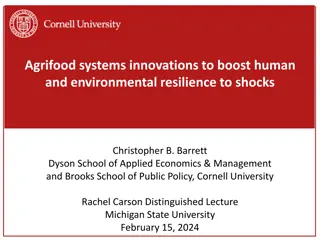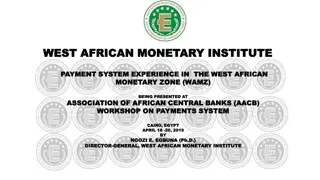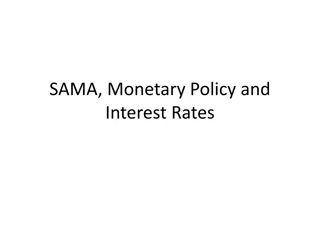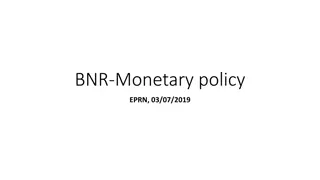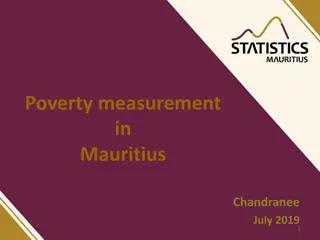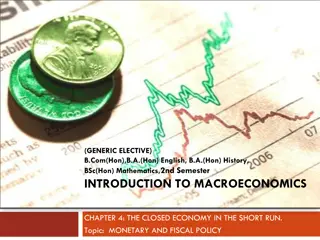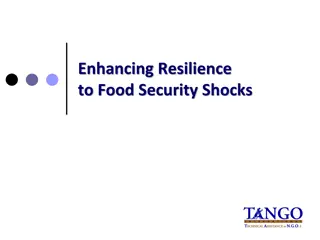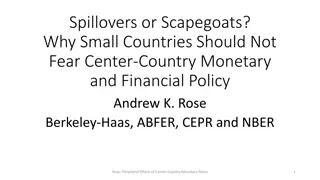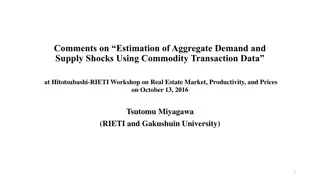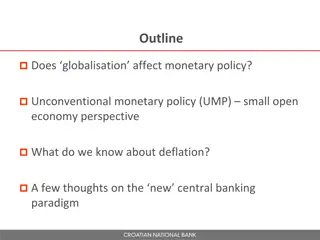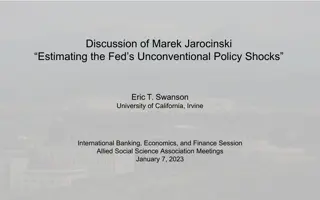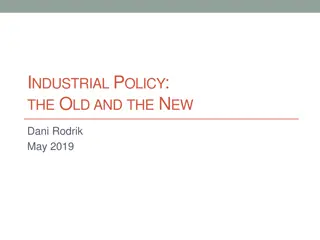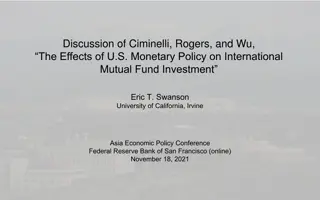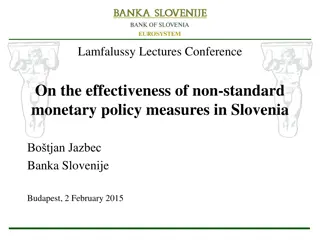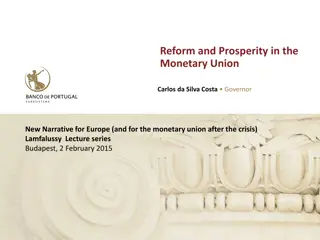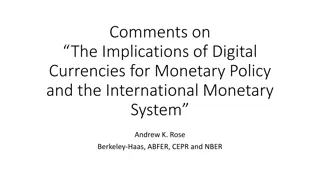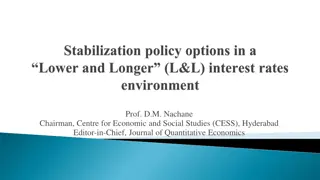U.S. Monetary Policy Spillovers to Middle East and Central Asia: Shocks and Fundamentals Impact
The research explores the impact of U.S. monetary policy spillovers on the Middle East and Central Asia regions, focusing on shocks and country fundamentals. It examines historical data, model analysis, and the 2022 tightening effects. The study reveals that both contractionary monetary policy shocks and positive information news shocks have varying effects on economic growth, influenced by country-specific fundamentals. The findings highlight the importance of understanding the interactions between different shocks and regional factors in shaping economic outcomes.
Download Presentation

Please find below an Image/Link to download the presentation.
The content on the website is provided AS IS for your information and personal use only. It may not be sold, licensed, or shared on other websites without obtaining consent from the author.If you encounter any issues during the download, it is possible that the publisher has removed the file from their server.
You are allowed to download the files provided on this website for personal or commercial use, subject to the condition that they are used lawfully. All files are the property of their respective owners.
The content on the website is provided AS IS for your information and personal use only. It may not be sold, licensed, or shared on other websites without obtaining consent from the author.
E N D
Presentation Transcript
U.S. Monetary Policy Spillovers to Middle East and Central Asia: Both Shocks and Fundamentals Matter Giovanni Ugazio (WHD) and Weining Xin (MCD) December 8th, 2022 1
Outline Motivations and main results Walkthrough of empirical flow Model and historical analysis The 2022 tightening Conclusion and way forward 2
Motivations Sharp reversal of global financial conditions in 2022 as headwind to growth but not much empirical work to support a quantification of the actual impact in the ME & CA region Paper related to 3 streams of literature: U.S. monetary policy external spillovers Fed information effects Role of country fundamentals in influencing spillovers 3
Summary of Results Historically Contractionary monetary policy shocks negative growth impact Weaker fundamentals see larger and more immediate growth declines Positive information news shocks positive growth impact Weaker fundamentals may see comparatively larger growth increases Shocks can mitigate or reinforce each other depending on underlying tightening motivation (e.g., AD vs AS driven inflation push) Global factors (VIX and oil prices) also matter 2022 tightening Slightly expansionary monetary policy shock but negative information news shock Average regional impact is small with large degree of heterogeneity Oil exporters and strong fundamentals fare better 4
Empirical Flow of the Paper Research Questions Steps of Empirical Analysis 5
Monetary Policy Shocks vs. Information News Shocks Fed information effects : The FOMC announcements embed information about their assessment of the U.S. economic conditions Announced changes to U.S. monetary policy stance are driven by the interplay of two underlying shocks: Pure monetary policy shocks: unexpected monetary policy stance shifts Information news shocks: Fed information effects Tightening could be driven by: Contractionary monetary policy shocks adverse spillovers Positive Information news shocks positive spillovers Important to identify and decompose the shocks for spillover analysis 6
Opposite Growth Spillovers from Two Shocks Contractionary monetary policy shocks negative growth impact Positive information news shocks positive growth impact Effects of a standard deviation of shocks on real GDP (percentage points) Notes: Solid lines report point estimates, and shaded areas represent 90 percent confidence bands. X- axes denote the response horizon (in years), with 0 being the year of the shocks. Y-axes denote the magnitude of the responses (in percentage points). Estimates are normalized to show responses to a standard deviation of the shocks. 7
MP Shocks: Weaker Fundamentals Suffer More Lower FX reserves, higher external debt, weaker fiscal balance, and higher public debt are associated with larger and more immediate growth decline FX Reserves External Debt Fiscal Balance Public Debt 8
IN Shocks: Weaker Fundamentals May Gain More Higher external debt and weaker fiscal balance are associated with larger growth increases; could be explained by risk-taking channel FX Reserves Public Debt Fiscal Balance External Debt 9
Global Risk Appetites Amplify Spillovers Contractionary monetary policy shocks: higher VIX is associated with larger growth declines Positive information news shocks: lower VIX is associated with larger growth increases Contractionary Monetary Policy Shocks (Percentage Points) Positive Information News Shocks (Percentage Points) 10
High Oil Prices Dampen Spillovers for Oil Exporters Contractionary monetary policy shocks: higher oil prices are associated with lower growth declines Positive information news shocks: higher oil prices are associated with lower growth gains Contractionary Monetary Policy Shocks (Percentage Points) Positive Information News Shocks (Percentage Points) 11
Spillovers from the 2022 Tightening The 2022 FOMC s announcements are estimated to have both MP and IN shocks negative Unsurprising monetary policy tightening, but pessimistic view of U.S. economic outlook Average spillovers is small: -0.2pp in 2022 and -0.8 pp in 2023 However, large degree of heterogeneity The impact of the 2022 tightening cycles on 2023 growth (percentage points) Oil Exporters Oil Importers Weak fundamentals -2.1 -4.0 Strong fundamentals -0.3 -2.2 Notes: Reserves at the 25th percentile, external debt at the 75th percentile, fiscal balance at the 25th percentile, and public debt at the 75th percentile of the entire sample for weak fundamentals and reserves at the 75th percentile, external debt at the 25th percentile, fiscal balance at the 75th percentile, and public debt at the 25th percentile of the entire sample for strong fundamentals. 12
Conclusions Historically, Opposite spillovers from two shocks Highlight the importance of building buffers and strengthening fundamentals High oil prices dampen both spillovers, while global risk appetites amplify both spillovers Looking forward, Average regional impact is small with large degree of heterogeneity More aggressive than anticipated tightening and slowdown in the U.S. Contractionary monetary policy shocks Negative information news shocks 13
Identification and Estimation of Two Shocks Following the framework in Bu et al. (2021) and Ciminelli et al. (2022) Identify monetary policy shocks by exploiting the sensitivity of the U.S. zero- coupon yields with maturities of 1 to 30 years Estimate information news shocks by taking the residuals from projecting yields changes to the identified monetary policy shocks Contractionary monetary policy (MP) shocks and positive information news (IN) shocks take positive values 15
Local Projections for Spillover Estimation 16 ME & CA Countries 8 oil exporters: Algeria, Bahrain, Kazakhstan, Kuwait, Oman, Qatar, Saudi Arabia, and United Arab Emirates 8 oil importers: Armenia, Egypt, Georgia, Jordan, Lebanon, Morocco, Pakistan, and Tunisia Local projections ???,? ??,? ?+ 0 ???,???,? ?+ ??.?, ??,?+? ??,? 1= ??+ ??+ ????+ ????+ 1 ? = 0, ,T Monetary Policy Shock Information News Shock Dependent variable: log(real GDP), and its expenditure components. 16
Opposite Growth Spillovers from Two Shocks Contractionary monetary policy shocks hinder exports and consumption Positive information news shocks boost consumption, exports, and investment Contractionary Monetary Policy Shocks (Percentage Points) Positive Information News Shocks (Percentage Points) 17
Role of Country Fundamentals and Global Factors Country-specific fundamentals: FX reserves, external debt, fiscal balance, and public debt Global factors: VIX, and oil prices (for oil exporters) Estimation: Local projection with probability of being in low- or high- group (Auerbach and Gorodnichenko, 2013; Ramey and Zubairy, 2018) Probability of z in the below-median group Probability of z in the above-median group ??,?+? ??,? 1 = ??+ ?? ?1 ? ??,? ?? ??,???+ ?? ?1 ? ??,? ?? ??,??? ??+ ?? ??+ ?? ? ?? ??,? ??,? ?+ 0 ? ???,? ???,? ???,? ? = 0, ,? ???,? + 1 + 0 1 ? ??,? ?? ??,???,? ?+ ??.?, ??,? ?+ 1 1 ? ??,? ??,? ? with ? ??,? = ? ???,?/(1 + ? ???,?), ? > 0 18
U.S. Monetary Tightening in 2022 Led to Tighter Global Financial Conditions Six consecutive rate increases of total 375 bps ME & CA countries responded by Raising interest rates Reducing bond issuances Policy rates (Percentage points) Sovereign bond issuance (US$ billion) 19
Opposite Macro-Financial Spillovers Sovereign Spreads (Basis points) Stock Indexes (Percentage points) Exchange Rate (National Currency Per US Dollar) (Percentage points) Portfolio Flows (% of Beginning Allocation) (Percentage points) 20
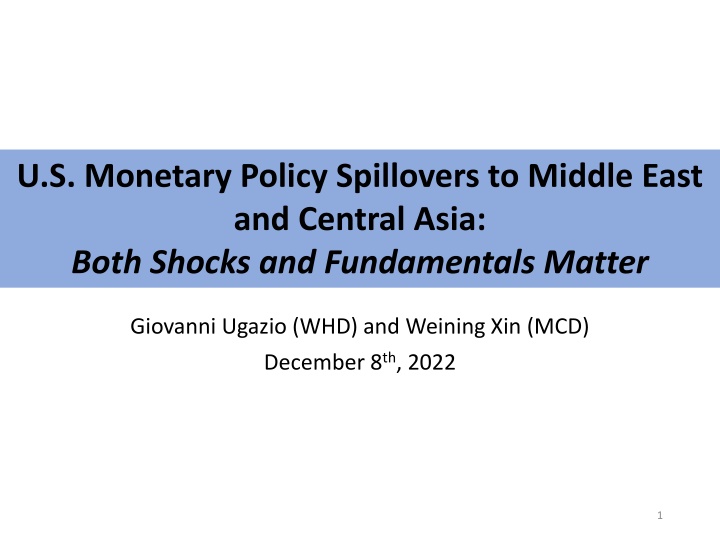

![READ⚡[PDF]✔ Emerging Space Powers: The New Space Programs of Asia, the Middle Ea](/thumb/21554/read-pdf-emerging-space-powers-the-new-space-programs-of-asia-the-middle-ea.jpg)
